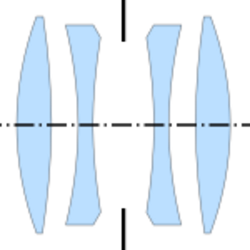Engineering:Celor lens
From HandWiki
A Celor lens (also known as a symmetric dialyte)[1] is a highly corrected lens of the Dialyt type, designed for process photography, involving reproduction at or near 1:1 scale.
Design
It was developed in 1898 by Emil von Hoegh, as a development of his earlier Dagor lens (1892) designed for the German company Goerz.[1][2] It was originally named the Double Anastigmat Goerz [Dagor] Type B, sold in both f/4.5 and f/6.3 versions; in 1904, the faster f/4.5 version was renamed to the Celor and the f/6.3 version was renamed to the Syntor.[3]:100
Similar four-element air-spaced symmetric dialyte lenses were released by Steinheil (Unofocal, 1901), Kodak, and Taylor, Taylor & Hobson (Aviar, 1917).[3]:100–101
References
- ↑ Jump up to: 1.0 1.1 Geary, Joseph (2002). "Celor Lens". Introduction to lens design with practical ZEMAX examples. Richmond, Va: Willmann-Bell. ISBN 978-0-943396-75-0.
- ↑ Born, Max (1999). Principles of optics: electromagnetic theory of propagation, interference and diffraction of light. Cambridge New York: Cambridge University Press. p. 265. ISBN 978-0-521-64222-4.
- ↑ Jump up to: 3.0 3.1 Kingslake, Rudolf (1989). "6: The First Anastigmats". A history of the photographic lens (1st, hardback ed.). San Diego: Academic Press. pp. 81–102. ISBN 0124086403. https://archive.org/details/historyofphotogr0000king/page/100/mode/2up.
 |


